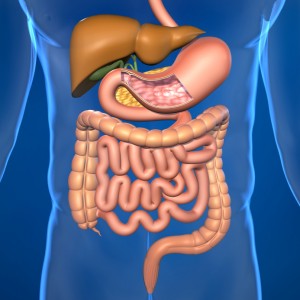The Road to Health is Paved with Good Intestines #5: The Small Intestine
 When we last left the gastrointestinal tract we were in the stomach where stomach acid and enzymes in conjunction with the mechanical forces of the stomach’s muscles were breaking down our food into a liquid known as chyme. When the gate at the bottom of the stomach called the pyloric sphincter opens, the chyme leaves the stomach and begins travelling into the small intestine.
When we last left the gastrointestinal tract we were in the stomach where stomach acid and enzymes in conjunction with the mechanical forces of the stomach’s muscles were breaking down our food into a liquid known as chyme. When the gate at the bottom of the stomach called the pyloric sphincter opens, the chyme leaves the stomach and begins travelling into the small intestine.
Despite its name, the small intestine is the longest part of the gastrointestinal tract with the average length of 22 feet. If this wasn’t big enough, if you were to pull it completely taught, the surface area would be the size of a tennis court. This is because the inner surface is shaped into a multitude of finger like projections called villi. When you look at it under a microscope it resembles the Down East coast of Maine. This giant surface area increases the nutrient absorption ability of the small intestine.
Before digestion and absorption can be completed more digestive enzymes and other chemicals are needed to continue breaking things down. Some of these enzymes are released directly by the cells of the lining of the small intestine. Others are released through a small connecting tube by the pancreas. Bile, released by the liver and stored in the gallbladder is squirted in to emulsify fats in a similar way to how dish detergent works to clean grease off of pans. Once the chyme is mixed is mixed with these enzymes and chemicals the carbohydrates, fats, proteins, vitamins, and minerals are then absorbed across the lining into the blood stream.
In addition to its functions of digestion and absorption, the small intestine houses 70% of your immune system and helps to distinguish between molecules you can absorb and friendly bacteria from non-digestible food particles and pathogenic organisms. More of your immune system is located in your gut than any organ in your body because it comes into contact with more foreign molecules and organisms than any other organ and the lining of the small intestine is only one cell thick.
When your gut immune system is working well it is able to handle the load that it is exposed to on a daily basis. However, a number of factors can cause it to become overwhelmed such as:
- Eating food high in sugar and unhealthy fats
- Eating a diet low in fiber
- Incomplete digestion caused by low stomach acid or impaired digestive enzyme function.
- Exposure to food allergens or environmental toxins
- Excessive or chronic stress
- Nutrient deficiencies
- Viral, bacterial, or fungal infections.
- Imbalances or overgrowth of normal gut microbes.
When the gut immune system becomes overwhelmed the single cell lining of the small intestine can become damaged leading to a leak in the barrier. This can allow semi digested food particles and bacterial toxins to cross the barrier leading to food allergies and inflammation. More and more evidence is linking inflammation and altered immune response in the gastrointestinal tract with chronic illnesses ranging from rheumatoid arthritis to heart disease to certain forms of cancer.
Luckily there are simple steps that you can take to help support a health small intestine and the gut immune system.
- Eat a diet that contains optimal levels of nutrients to support the gut immune system including: vitamin A (green leafy vegetables, yellow and orange vegetables, fruits, egg yolks, and oily fish such as sardine), vitamin C (citrus fruit, blackberries, raspberries, kiwis, cruciferous vegetables, and sweet potatoes), zinc (pumpkin seeds, whole grains, and legumes), and fiber (fruits, vegetables, legumes, whole grains, nuts, and seeds).
- Consume foods high in glutamine. Glutamine is an amino acid that is used by the cells of the small intestine for fuel. Good food sources include: cabbage, spinach, fish, chicken, eggs, legumes, nuts, seeds, and parsley.
- Eat healthy fats. Healthy fats can help to support proper immune function and reduce inflammation. Good food sources of fats include wild cold water fish (sardines, salmon, and anchovies), avocados, olive oil, walnuts, almonds, coconut oil, pumpkin seeds, flax oil, and flax seeds.
- Maintain optimal levels of stomach acid. As mentioned in the last blog, stomach acid helps to destroy harmful bacteria, parasites, and viruses. By getting rid of them before they get to the small intestine it decreases the load that the gut immune system has to deal with.
- Avoid food allergens and food sensitivities. Eating foods that you are allergic to or that you are sensitive to can over activate your gut immune system leading to further damage and inflammation. An allergy elimination diet can be helpful in identifying foods you are reacting to.
- Reduce stress. Stress increases your inflammatory response and has a negative impact on the gut-immune system. Exercise, meditation, yoga, journaling, massage, and breathing exercises can all help reduce the stress response.
Anything that was not absorbed in the small intestine will continue its way down the gastrointestinal tract where it will serve as food for our gut bacteria and ultimately be excreted. In the next blog we will finish our journey through the gastrointestinal tract as we make our way through the large intestine and meet the trillions of bacteria that call it home.
